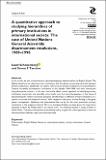Files in this item
A quantitative approach to studying hierarchies of primary institutions in international society : the case of United Nations General Assembly disarmament resolutions, 1989–1998
Item metadata
| dc.contributor.author | Schouenborg, Laust | |
| dc.contributor.author | Taeuber, Simon F. | |
| dc.date.accessioned | 2020-12-18T10:30:11Z | |
| dc.date.available | 2020-12-18T10:30:11Z | |
| dc.date.issued | 2021-06-01 | |
| dc.identifier | 271669806 | |
| dc.identifier | 705aaf92-3f9b-4f92-8beb-1cc91dff5dd8 | |
| dc.identifier | 85092734543 | |
| dc.identifier | 000583682800001 | |
| dc.identifier.citation | Schouenborg , L & Taeuber , S F 2021 , ' A quantitative approach to studying hierarchies of primary institutions in international society : the case of United Nations General Assembly disarmament resolutions, 1989–1998 ' , Cooperation and Conflict , vol. 56 , no. 2 , pp. 224-241 . https://doi.org/10.1177/0010836720965998 | en |
| dc.identifier.issn | 0010-8367 | |
| dc.identifier.other | ORCID: /0000-0003-0740-3366/work/85168582 | |
| dc.identifier.uri | https://hdl.handle.net/10023/21177 | |
| dc.description.abstract | In this article, we aim to contribute to two contemporary debates within the English School. The debate about how to observe primary institutions and the debate concerning hierarchy between primary institutions. Specifically, we analyse references to primary institutions in United Nations General Assembly disarmament resolutions in the decade 1989–1998 and their distribution using descriptive statistics. In this way, the article offers a novel approach to identifying primary institutions empirically, and provides some insight into the hierarchy-question in the sense of documenting the relative numerical presence of references to different primary institutions in a specific issue area and temporal context. With respect to the latter, the key finding is that great power management, diplomacy and international law are by far the most prominent primary institutions in the analysed material. This is an intriguing finding, not least given the importance attached to them by Hedley Bull in his classic work The Anarchical Society: A Study of Order in World Politics. The main contribution of the article is thus to spell out a new approach to how the aforementioned debates might proceed empirically. | |
| dc.format.extent | 18 | |
| dc.format.extent | 430398 | |
| dc.language.iso | eng | |
| dc.relation.ispartof | Cooperation and Conflict | en |
| dc.subject | Disarmament | en |
| dc.subject | English School | en |
| dc.subject | Hierarchy | en |
| dc.subject | International society | en |
| dc.subject | Primary institutions | en |
| dc.subject | United Nations | en |
| dc.subject | JZ International relations | en |
| dc.subject | 3rd-DAS | en |
| dc.subject | NIS | en |
| dc.subject.lcc | JZ | en |
| dc.title | A quantitative approach to studying hierarchies of primary institutions in international society : the case of United Nations General Assembly disarmament resolutions, 1989–1998 | en |
| dc.type | Journal article | en |
| dc.contributor.institution | University of St Andrews. School of International Relations | en |
| dc.contributor.institution | University of St Andrews. Centre for Global Law and Governance | en |
| dc.identifier.doi | https://doi.org/10.1177/0010836720965998 | |
| dc.description.status | Peer reviewed | en |
This item appears in the following Collection(s)
Items in the St Andrews Research Repository are protected by copyright, with all rights reserved, unless otherwise indicated.

